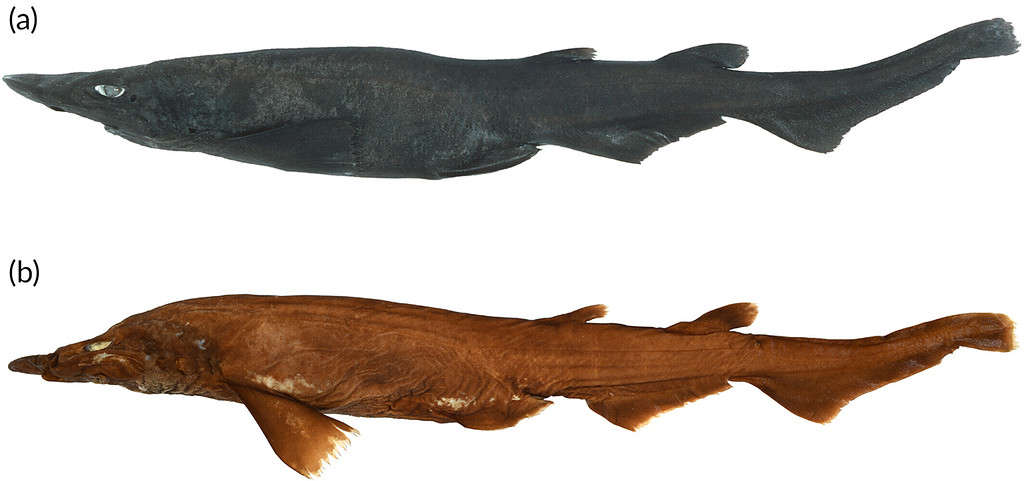
A new species of shark, with bright, white eyes, has emerged from the depths of Australian waters. Unlocking the secrets of this mysterious creature has led scientists on an incredible journey of exploration and scientific detective work.
Christened Apristurus ovicorrugatus, the new species belongs to a group of sharks known to lay eggs rather than give birth to live pups. Its bright white irises are highly unusual among deepwater fish, making them both spooky but also highly intriguing.
Mysterious Eggs
The discovery of the new shark species began in the unassuming halls of a museum, where a number of peculiar egg cases at the Australian National Fish Collection sparked scientists’ curiosity.
These protective casings, often referred to as “mermaids’ purses,” protect the eggs of oviparous sharks, which lay eggs instead of giving birth to live young.
However, these particular egg cases were unique, adorned with intriguing ridges along their length. The researchers believed that these cases belonged to a species from the Apristurus genus, but their origin was very much unclear.
Fast forward a decade and two more of these enigmatic egg cases were discovered in the Australian National Fish Collection. This finding ignited a spark of curiosity within the research team, propelling them on a quest to solve the puzzle of these mysterious egg cases.
They delved into databases, searching for Apristurus-type sharks sighted in the same areas where the egg cases were found. And there, buried in misclassification, they unearthed a crucial clue.
The research team made a startling revelation— a shark that had been misidentified held the key to unraveling the enigmatic eggs.
It turned out that this misidentified shark had been pregnant at the time of its demise, carrying within its body an egg case that perfectly matched the three found in the museum.
With this newfound knowledge, the team could finally put a name to the enigmatic species—the Apristurus ovicorrugatus.
A Species Unlike Any Other
Apristurus ovicorrugatus, with its bright, white eyes, captivates the imagination. This species belongs to a diverse group of sharks known as ghost or demon catsharks due to their appearance.
Their elongated catlike eyes give them an otherworldly appearance, lending an air of spookiness to their presence. However, it is the bright white irises of the Apristurus ovicorrugatus that truly set them apart from their deep-sea counterparts.
Why would a shark have such strikingly white eyes? Helen O’Neill, a research technician and one of the authors of the study, suggests that these bright white irises might help the shark navigate the darkness of the deep sea.
In a world where light is scarce, having eyes that stand out like beacons could be a significant advantage, allowing the shark to spot prey or potential threats lurking in the shadows.
Reproduction in sharks is a diverse and intricate process. Some give birth to live young, while others lay eggs. The Apristurus genus has its own distinctive mode of egg-laying—one that adds to the intrigue surrounding Apristurus ovicorrugatus. These sharks lay their eggs in pairs, with one egg case for each ovary.
The scientific journey to establish the Apristurus ovicorrugatus as a new species was not without its challenges. Initially, the research team faced obstacles in obtaining genetic material for analysis. But the discovery of egg cases with embryos late last year yielded the precious genetic material needed to solidify the case for a new species.
But the discovery of egg cases with embryos late last year yielded the precious genetic material needed to solidify the case for a new species.
Armed with the genetic evidence and through meticulous examination of egg case morphology, as well as studying teeth, scales, livers, and other characteristics, they pieced together a comprehensive profile of this new species.
Apristurus ovicorrugatus has emerged from the shadows of the deep, revealing itself as a fascinating addition to the underwater realm. Its bright white eyes, a rarity among deep-sea creatures, capture the imagination and hint at its unique adaptations for life in the darkness.
As scientists continue to explore the vast oceans, new discoveries await, providing glimpses into the extraordinary diversity of life hidden beneath the waves.
The findings appeared in the Journal of Fish Biology.






